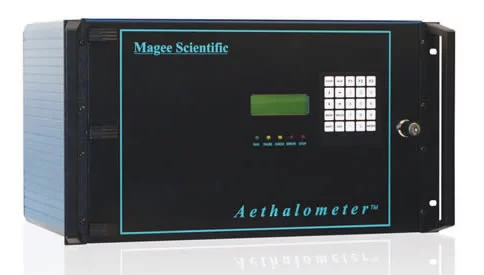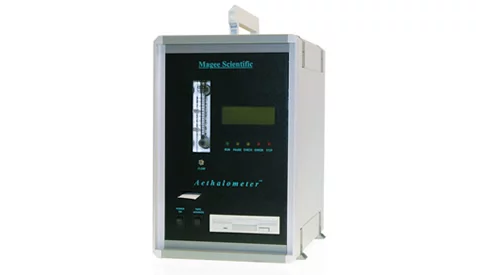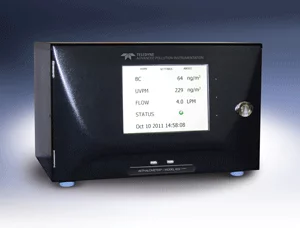The Aethalometer provides a real-time optical measurement of light absorbing carbonaceous aerosols (mainly black carbon) in 7 different wavelengths ranging from 370nm to 950nm. The principle of the Aethalometer is to measure the attenuation (ATN) of a beam of light transmitted through a filter, while the filter is continuously collecting an aerosol sample. The ATN is measured through a "sensing" spot of the filter, on which the aerosol is collected, and a "reference" spot of the filter, as a check of the stability of the optical source. A mass flow meter monitors the sample air flow rate. The data from these three measurements is used to calculate the BC concentrations.
Most the filter based techniques which measure the aerosol absorption coefficient suffer from various systematic errors that need to be corrected. First on has to correct for multiple scattering by the filter fibers and the scattering of the aerosols embedded in the filter. A second correction needs to be applied due to the fact that the ATN is increased by the light absorbing particles accumulating in the filter which reduces the optical path for a loaded filter. For further information on the correction algorithms see Weingartner, E., et al: 2003 and Collaud Coen, M., Weingartner, et al. 2010
At PSI we have the AE31 model, which is used for several source apportionment studies, the smog chambers (Mobile Smog Chamber, Smog Chamber) and at the GAW station Jungfraujoch, and the portable AE42 model, which is used in the PEGASUS project. PSI was furthermore helping to develop (Aerosol d.o.o., Slovenia is leading the development) the new Aethalometer AE33 (Eurostar FC Aeth Project) which measures with a very high time resolution (1s) and in a way that no corrections are necessary. The final and commercially available version of the AE33 is currently deployed at PSI at several ambient, mobile and smogchamger campaigns.
Source Apportionment with the Aethalometer
Wood smoke is known to contain abundant organic materials such as polycyclic aromatic hydrocarbons (PAH), aromatics and humic-like substances (HULIS), which strongly enhance the absorption of light in the ultraviolet wavelength range compared to that in the near-infrared range, where BC dominates the absorption. Traffic emission particles from diesel engines contain a higher fraction of BC than organic material (Sandradewi et al 2008a). Light absorption measurements of ultra violet, visible and infrared wavelengths by a multiple wavelength Aehtalometer can therefore be used to quantitatively assess the source contribution of wood burning versus traffic as it was show by In Sandradewi et al. 2008b.
This model can be calibrated with analyses from the 14C method using HIVOL filter measurements and compared with corresponding factors found by PMF analysis of AMS data.
This model can be calibrated with analyses from the 14C method using HIVOL filter measurements and compared with corresponding factors found by PMF analysis of AMS data.
Projects
Publications
-
Weingartner E, Saathoff H, Schnaiter M, Streit N, Bitnar B, Baltensperger U
Absorption of light by soot particles: determination of the absorption coefficient by means of aethalometers
Journal of Aerosol Science. 2003; 34(10): 1445-1463. https://doi.org/10.1016/S0021-8502(03)00359-8
DORA PSI -
Collaud Coen M, Weingartner E, Apituley A, Ceburnis D, Fierz-Schmidhauser R, Flentje H, et al.
Minimizing light absorption measurement artifacts of the Aethalometer: evaluation of five correction algorithms
Atmospheric Measurement Techniques. 2010; 3(2): 457-474. https://doi.org/10.5194/amt-3-457-2010
DORA PSI -
Sandradewi J, Prévôt ASH, Weingartner E, Schmidhauser R, Gysel M, Baltensperger U
A study of wood burning and traffic aerosols in an Alpine valley using a multi-wavelength Aethalometer
Atmospheric Environment. 2008; 42(1): 101-112. https://doi.org/10.1016/j.atmosenv.2007.09.034
DORA PSI -
Sandradewi J, Prévôt ASH, Szidat S, Perron N, Alfarra MR, Lanz VA, et al.
Using aerosol light abosrption measurements for the quantitative determination of wood burning and traffic emission contribution to particulate matter
Environmental Science and Technology. 2008; 42(9): 3316-3323. https://doi.org/10.1021/es702253m
DORA PSI -
Segura S, Estellés V, Titos G, Lyamani H, Utrillas MP, Zotter P, et al.
Determination and analysis of in situ spectral aerosol optical properties by a multi-instrumental approach
Atmospheric Measurement Techniques. 2014; 7(8): 2373-2387. https://doi.org/10.5194/amt-7-2373-2014
DORA PSI -
Drinovec L, Močnik G, Zotter P, Prévôt ASH, Ruckstuhl C, Coz E, et al.
The "dual-spot" Aethalometer: an improved measurement of aerosol black carbon with real-time loading compensation
Atmospheric Measurement Techniques. 2015; 8(5): 1965-1979. https://doi.org/10.5194/amt-8-1965-2015
DORA PSI -
Crilley LR, Bloss WJ, Yin J, Beddows DCS, Harrison RM, Allan JD, et al.
Sources and contributions of wood smoke during winter in London: assessing local and regional influences
Atmospheric Chemistry and Physics. 2015; 15(6): 3149-3171. https://doi.org/10.5194/acp-15-3149-2015
DORA PSI




